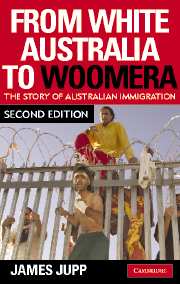Book contents
- Frontmatter
- Contents
- Acronyms and abbreviations
- Introduction
- Chapter 1 Creating an immigrant society, 1788–1972
- Chapter 2 From assimilation to a multicultural society, 1972–2006
- Chapter 3 The Fraser, Hawke and Keating governments, 1975–1996
- Chapter 4 Policy instruments and institutions
- Chapter 5 Multicultural policy
- Chapter 6 The attack on multiculturalism
- Chapter 7 The impact of One Nation
- Chapter 8 Economic rationalism
- Chapter 9 Sustainability and population policy
- Chapter 10 Refugees and asylum seekers
- Chapter 11 Immigration in a global world
- Appendix I Chronology: 1972–2007
- Appendix II Ministers for immigration, departmental secretaries and gross annual settler intake, 1973–2006
- References
- Index
Chapter 2 - From assimilation to a multicultural society, 1972–2006
Published online by Cambridge University Press: 03 May 2010
- Frontmatter
- Contents
- Acronyms and abbreviations
- Introduction
- Chapter 1 Creating an immigrant society, 1788–1972
- Chapter 2 From assimilation to a multicultural society, 1972–2006
- Chapter 3 The Fraser, Hawke and Keating governments, 1975–1996
- Chapter 4 Policy instruments and institutions
- Chapter 5 Multicultural policy
- Chapter 6 The attack on multiculturalism
- Chapter 7 The impact of One Nation
- Chapter 8 Economic rationalism
- Chapter 9 Sustainability and population policy
- Chapter 10 Refugees and asylum seekers
- Chapter 11 Immigration in a global world
- Appendix I Chronology: 1972–2007
- Appendix II Ministers for immigration, departmental secretaries and gross annual settler intake, 1973–2006
- References
- Index
Summary
The Australian experience of immigration was historically with those from the United Kingdom. Before 1921 this included a large component of Catholic Irish, but these had almost ceased to arrive after the depression of the 1890s. England has always provided the largest number of the United Kingdom-born, followed by Ireland in the nineteenth century and Scotland in the twentieth. The Scots replaced the Irish by 1921 and were only replaced by Italians in 1961. The English have always been the largest overseas-born group to the present. Only in 1996 did New Zealand replace the United Kingdom as the single largest national source of newcomers, and that was reversed again by 2003.
As Sir Henry Parkes put it before Federation, ‘the crimson thread of kinship runs through us all’. Himself an English migrant, Parkes ignored the Indigenous and Chinese populations who made up less than 5 per cent of the population. As premier of New South Wales in 1881 he warned Italians not to congregate together because it would delay their assimilation. He dispersed them throughout the colony as a condition of settlement aid. He was also hostile to Irish Catholic immigration and advocated its limitation. Most of his attitudes were widespread in late colonial Australia and represent majority opinion at the time of Federation in 1901.
- Type
- Chapter
- Information
- From White Australia to WoomeraThe Story of Australian Immigration, pp. 19 - 36Publisher: Cambridge University PressPrint publication year: 2007



